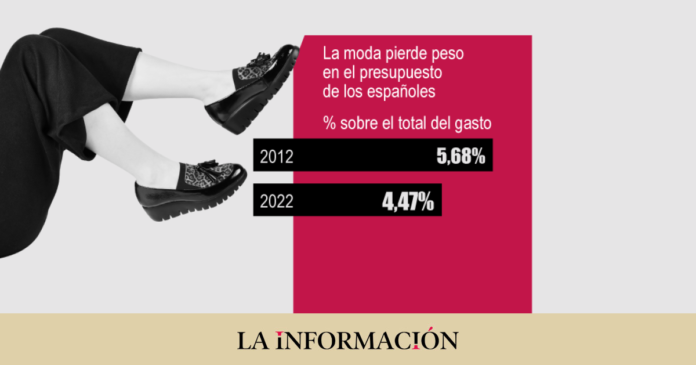The world population suffered the Great Recession, Obama began his second term in the White House and Curiosity landed on Mars. It was 2012 and the Spanish preferred to buy a shirt than a mobile, a balance that has not survived the test of time. Fashion has lost weight in the Spanish budget: in fact, clothing and footwear is the category that has fallen the most, while communications, which range from an electronic device such as a mobile or tablet, to Amazon spending Prime, you’ve grown strong. If before, clothing and footwear accounted for 5.7% of Spanish spending, now it represents 4.5%, losing almost one point in ten years and becoming the sector that falls the most.
Last year, each Spaniard spent an average of 498.59 euros at constant prices on clothing and footwear, according to data from the Family Budget Survey of the National Statistics Institute (INE) published this week. The data is far from what consumers spent ten years ago on fashion, a figure that amounted to 547.97 euros per person. During the years of the crisis, consumers were lowering the money they spent on buying a pair of pants or a T-shirt and, despite the fact that the recovery increased spending in the sector, the figure never returned to pre-crisis levels. In 2017, before the Great Recession, each Spaniard spent 769.78 euros per year on clothing and footwear.
However, this year’s figure is the highest in the last three years, increased by inflation and the low comparable base impacted by the pandemic. Taking into account the rise in prices, fashion spending in 2022 increased by 8.5% year-on-year. When discounting it, at constant prices, the increase falls to 2.5%.
With or without inflation, fashion is the sector that is worst off in the new order of consumer priorities. At constant prices, fashion has lost 1.21 points in the Spanish basket, up to 4.5% in 2022. After fashion, the sector that has lost the most weight in Spanish spending, discounting inflation, is the food and non-alcoholic beverages, which lost one percentage point in the budgets, going from 14.9% to 13.9%. Taking into account the rise in prices, the scheme changes and becomes the sector that gains more importance. Other sectors such as alcoholic beverages and tobacco or restaurants and hotels have also lost weight, but in a much more moderate way, with falls of 0.4% and 0.5%, respectively. For their part, leisure and culture maintained practically the same importance over the total as in 2012.
Importance of fashion in the family budget
Thus, the sector that has gained greater importance in family budgets is neither restaurants, nor leisure, nor clothing, it is communications. This category covers the purchase of devices such as a mobile or fax to postal services. In fact, the INE points out among its examples one of the expenses that this category fattens: Amazon Prime. The shipping costs of buying items online also add weight to this category if they are spent separately. A curious detail is that, like fashion, this sector as a whole has been deflationary in the last decade: it is for this reason that, at current prices, communications did not gain ground, but rather stagnated, with a slight decrease in the share of 0.12 points.
In 2022, each Spaniard spent 374.3 euros on communications, a figure that, if it exceeds that of ten years ago, when Spaniards spent an average of 336 euros per year in this category. In family budgets as a whole, communication accounts for 6.6% of the shopping basket, which places it in seventh position in the ranking, a place that fashion occupied ten years ago.
In total, the average cost per person was 12,780 euros last year, with an increase of 8.5% compared to 2021. Discounting the price rise, the increase was only 2.5%. For its part, average household spending rose 7.9%, to 31,568 euros. At constant prices, the increase was 2%.

